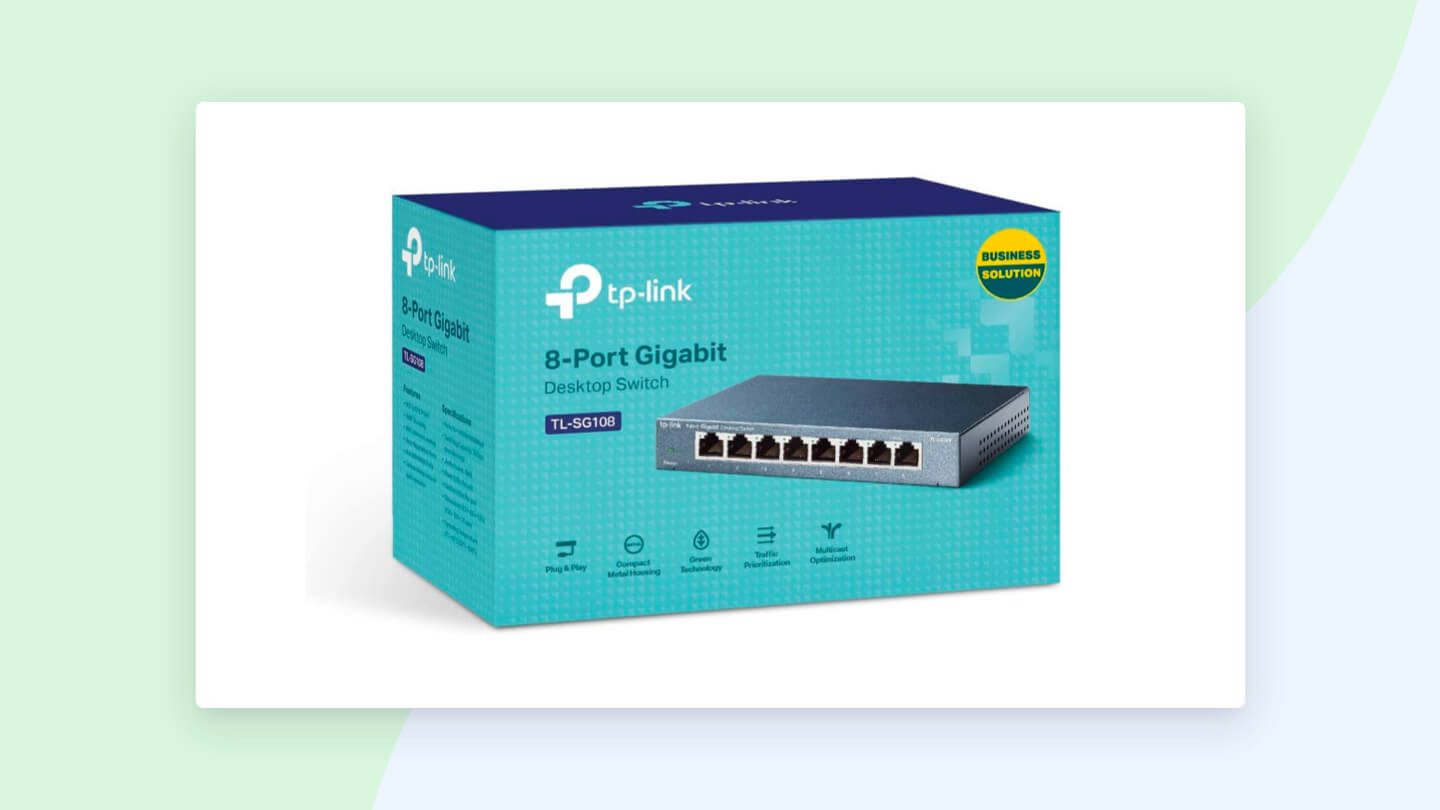A network switch, also called an Ethernet switch, is a device that connects different devices on a computer network. It operates by using packet switching, a way to group data, to send data and receive data to certain devices. To put it simply, a network switch is a way to add more ports to your router.
The network switch is used as part of a larger computer network. It requires data cables to connect the devices, which are plugged into the switch device itself.
Someone who wants their network to run with more efficiency may want to consider a network switch. It’s often used to replace an Ethernet hub, which cannot distinguish between different recipients.
Different types of Ethernet network switches
There are three main types of network switches:
Unmanaged switches
Unmanaged switches have no options or configuration interface. You simply plug your cables into the device. As such, they tend to be the least expensive and are best suited for small office or home use.
For unmanaged switches, TP-Link is a popular brand that has some devices at a lower price point than some competitors. The eight-port device has a normal price of $39.99 through Amazon, while the 16-port option sits at $67.91 at the time of writing. These can go on sale, currently at $17.99 for the 8-port model. They also have a very respectable 4.8 out of 5 rating on Amazon at the time of writing. You can also find a variety of options other models don’t have, like five-port models. This brand also has a limited lifetime warranty, unlike some main competitors.
TP-Link TL-SG108

Image credit: Amazon
Managed switches
Unlike unmanaged switches, managed switches have different ways to change how the switch operates. You might see different ways to control the device that include a command-line interface, a simple network management protocol or a web interface using a browser. Some managed switches, especially those with web interfaces, may be referred to as smart switches on the market.
Your best options for these devices will depend on how many devices you need to hook into the switch. For smaller-scale use, the five-port and eight-port Zyxel models are both web-managed and come with lower price points of $24.99 and $42.99 respectively, both on sale at the time of writing for around $20. The eight-port model has a 4.4 rating at the time of writing and the five-port model has a 4.2 rating.
Zyxel 5-Port Gigabit Web

Image credit: Amazon
For slightly larger-scale uses, the Cisco 10-port managed device comes with a $269 price point, though it can be on sale for over $100 off. It has a 4.4 rating at the time of writing. It boasts easy-to-use control features like a network manager and a command-line interface, as a few examples.
Once you go into the larger 24 or 26-port devices, it’s common to see them labeled as smart devices.
CISCO SG350-10

Image credit: Amazon
Smart/intelligent switches
These have a limited set of management options. The switches are set up to operate themselves in the most efficient way possible. Some may provide a web interface similar to the managed switches and allow consumers to manipulate basic settings like VLANs, port-bandwidth and duplex. Web managed switches fall between managed and smart switches for category.
TP-Link has a smart managed 24-port device at an attractive $99.99 price point. It’s rated as good for large file transfers.
TP-Link 24 Port Gigabit Switch

Image credit: Amazon
Allconnect® is a participant in the Amazon Services LLC Associates Program, an affiliate advertising program designed to provide a means for us to earn fees by linking to Amazon.com and affiliated sites. However, Allconnect is responsible for all content on this page.
What to look for when purchasing a network switch
Network switches can be complex devices with a number of features. To find the best Ethernet switch for your situation, consider the following factors:
- Price: Network switches can run from around $20 to over $250. Different features can affect the price, like how many ports the device has or how smart the device is.
- Reviews: Always take a look at reviews, both through Amazon and a consumer advocacy group, if you can. These will likely tell you how easy it actually is to use the device in. If the device uses more power than you’d think it would, reviews will often state this issue, as well.
- Number of ports: This is one of the most important features. You want to make sure you can link in all your devices and the cables they require, but not overpay for ports you will never use.
- Warranty: Some devices come with different warranties. It’s common to see limited lifetime warranties or three-year hardware limited warranties. Review the warranty information carefully to see what can be replaced and when.
- Gigabits: Many devices will list how many gigabits they can handle. This relates to the speed of the transmission. You’ll see rates for Mbps or Gbps, or megabits per second or gigabits per second. Switches tend to detect and handle speeds automatically.
- Support services: Make sure you check to see what type of support services are available. For instance, some devices list 24/7 tech support included.
- Managed features/ease of use: Consider carefully how you would manage the device, such as through web management or embedded protocols. The less you want to manually control the device, the more you may want to look into smart or intelligent devices.
Where to place network switches
Most people put network switches by the router so that it connects to the router directly. Most devices come with the ability to wall-mount the device so that it can stay out of the way and the cords won’t become a rat’s nest on the floor.
The placement should be out of view, since a large box with wires sticking out is never a good look. However, you should be able to easily access it to connect devices or configure settings. Make sure you can easily run cables to it and that it is less than 100 meters from the farthest room from which you need to wire devices.
As such, it’s common for people to place their devices in closets, in the garage if it is attached/close, in a utilities part of the home like a laundry room or the basement.
Network switch FAQs
That depends on how many ports the device offers. It’s common to see devices that have anywhere from five ports all the way up to 48 ports.
A network switch might be used to supplement router ports if your router has few ports or if you have many devices at one place. You might use a network switch to cut down on wireless interference or use wires to increase speed. It can be a good way to increase speed.
Allconnect: Let us compare providers for you
Why should you choose Allconnect? We’re the #1 broadband marketplace in the U.S, meaning you can trust us to search, compare and order internet and TV service for your home.
Get started
Written by:
Michelle Honeyager
Michelle Honeyager is a contributor for the Allconnect team. She has been writing professionally for over 10 years, and covers topics pertaining to home internet tech and internet service. She graduated from Mou…
Read more
Edited by:
Robin LaytonEditor, Broadband Content
-
Featured
![Ethernet cable speed categories explained]() Ethernet cable speed categories explained Camryn Smith — 5 min read
Ethernet cable speed categories explained Camryn Smith — 5 min read -
Featured
![30% of Americans say their internet is too slow. Here’s how to fix it]() 30% of Americans say their internet is too slow. Here’s how to fix it Joe Supan — 4 min read
30% of Americans say their internet is too slow. Here’s how to fix it Joe Supan — 4 min read -
Featured
![13 best Wi-Fi analyzers to boost your network speeds]() 13 best Wi-Fi analyzers to boost your network speeds Alex Sheehan — 5 min read
13 best Wi-Fi analyzers to boost your network speeds Alex Sheehan — 5 min read
Latest
-
Thursday, July 25, 2024
Worried about losing your signal? This is how to keep your satellite dish cleanDavid Anders — 6 min read
-
Tuesday, July 23, 2024
The best free TV and movie streaming services 2024Camryn Smith — 5 min read
-
Tuesday, July 23, 2024
Everything you need to know about internet speedsRobin Layton — 8 min read





